
* When Hitler's war machine invaded the Soviet Union in the summer of 1941, it swept all resistance before it. Luftwaffe fighters destroyed Russian aircraft in the air and on the ground with fearsome effectiveness, and German aces racked up huge numbers of "kills".
Many of the aircraft destroyed were old and obsolete types, but the Germans also encountered newer Soviet aircraft, some of which were not so easily shot out of the sky. Among these newer types was the Yakovlev "Yak-1" fighter. At the time it was not a match for the German Messerschmitt Bf 109, but in the coming years the Yak-1 and its successors would improve in quality and grow in numbers. In the end, they would fly unchallenged over a shattered Berlin. This document provides a history and description of the Yakovlev series of piston-engined fighters.
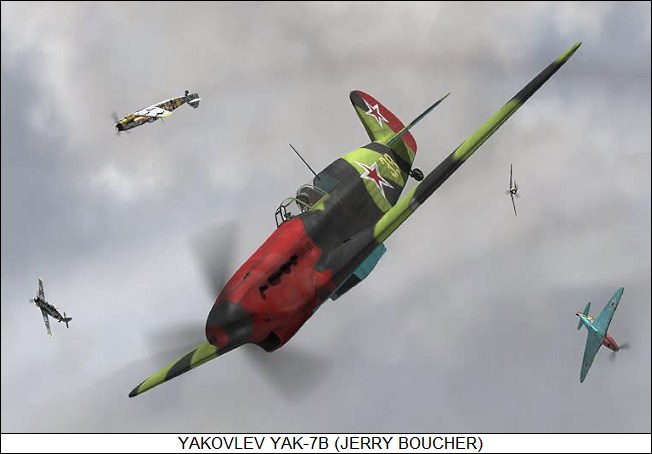
* Alexander Sergeyevich Yakovlev had developed a reputation in the Soviet aircraft design industry before World War II, designing a series of sport and training aircraft. He gained access to Soviet dictator Josef Stalin, and in April 1939 the Great Leader handed him a challenge. Stalin wanted a prototype of a new high performance fighter in months. Yakovlev protested: "But the Americans take two years to produce a fighter!" Stalin replied: "Well, you are not an American! Show us what a young Russian engineer can do! Prove your mettle and, if you do, I'll have you in for a cup of tea."
Yakovlev put his design bureau to work around the clock on the new fighter, which was designated "I-26" (where "I" stood for "Istrebitel / Destroyer", meaning "fighter"). This aircraft would be powered by the new Klimov M-105 vee-12 inline water-cooled engine, a Russian derivative of the French Hispano-Suiza HS-12Y engine. The aircraft would be armed with Shpital'ny-Komaritsky (ShKAS) machine guns and the 20-millimeter Shpital'ny-Vladimirov (ShVAK) cannon. Yakovlev was given top priority for resources. Stalin's Russia was clearly headed for war with Hitler's Germany, and Soviet air battles with the German Condor Legion in Spain showed the Red Air Force (Voyenno Vozdushniye Sily / VVS) to be lacking a fighter capable of taking on the new German Messerschmitt Bf 109.
The bright red I-26 prototype, fitted with skis, was rolled out of the shop on 13 January 1940. After some short taxi trials, Yakovlev's test pilot and long-time associate Yulian I. Piontkovski took the aircraft up and did two circuits around the airfield.
The aircraft was sleek and racy, and so the shop crew gave it the name "Krasavec (Handsome)". The I-26 was a sleek, low-wing monoplane with retractable taildragger landing gear. Construction was simple, some might say crude, though Yakovlev was firm in his belief that "simplicity is not primitiveness". Its frame was made of welded steel tubing, with the two main wing spars and many other structural elements made of wood, and most of the skin of the aircraft was covered with fabric. This was in accordance with the construction of the engineering of an earlier generation of fighters, but the Soviet Union lacked the light alloys to build metal stressed-skin fighters like the German Bf 109 and British Spitfire. Besides, the simple construction made the aircraft easier to produce and easy to maintain by minimally trained ground crews under austere field conditions.
The main landing gear pivoted from the wings into the belly of the aircraft, giving the new Yak fighter a comfortable wide track on the ground, useful for operating on rough forward airfields. The aircraft was powered by the Klimov M-105P engine variant, providing 820 kW (1,100 HP) for take-off. It was a carbureted engine with a two-stage two-speed supercharger. The engine drove a three-bladed propeller with hydraulic pitch control. The aircraft had four fuel tanks, nested between the wing spars.
The initial prototype was unarmed, but was designed to accommodate a ShVAK 20-millimeter cannon fitted between the cylinder banks to fire out the propeller spinner, with 120 rounds of ammunition. Secondary armament was to consist of two ShKAS 7.62-millimeter machine guns, mounted on the nose in front of the cockpit and synchronized to fire through the propeller arc. Two more machine guns were to have been mounted under the nose, but they were not fitted since they would have affected the machine's center of gravity.
The canopy was of "razorback" configuration, with its attendant poor view to the dangerous rear 6 o'clock position, and slid open backwards over the rear spine of the aircraft. It could be locked closed or open, but could not be jettisoned in an emergency. There was no armored glass, and in fact the only armor was an 8-millimeter plate that protected the head and shoulders of the pilot.
* There was obvious room for improvement in the I-26, but reports from the test pilots encouraged the Yakovlev design team to think they were on the right track. However, the group was dealt a severe blow when the prototype spun into the ground from low altitude on 27 April 1940, killing Piontkovski. The after-accident analysis concluded that the main landing gear had opened spontaneously in maneuvers, with the load causing structural failure of the wing. That was an emotional shock to the tight-knit group, but the accident did not seriously hinder the development program. The second prototype had already been rolled out and was used to complete the test program. Stalin had already ordered the I-26 into production anyway.
The second prototype differed from its predecessor in a number of small ways, with a larger oil-cooler intake under the nose, a redesigned tail, fixed tailwheel, and other changes. The aircraft began state acceptance trials on 10 June 1940. The pilots performing the evaluation found the I-26 to have excellent handling characteristics, comparing it to a trainer, as well as to be extremely agile, but reported it underpowered and also detailed many technical defects. There was no time to wait to fix everything, and even as the trials were in progress, more prototypes and elements of a preproduction batch were rolling off the assembly line. The type was first displayed to the public when five of them overflew Red Square during the annual October Revolution celebration on 7 November 1940. The identity of the aircraft was not announced.
BACK_TO_TOP* The first pre-production I-26 fighters rolled of the production lines of a Moscow plant and were passed on to a field evaluation unit. These aircraft were fully armed with the ShVAK 20-millimeter cannon and two ShKAS-7.62 millimeter machine guns. Pilots regarded the armament as too light, though Soviet aerial machine guns and cannons had rates of fire very roughly about half again greater than their Western counterparts as partial compensation. About one in five of the fighters were fitted with racks to carry six RS-82 82-millimeter rockets on underwing racks, which would be used for both air-to-ground and air-to-air combat. Although inaccurate, they would literally blow an enemy aircraft apart on a hit, and had delay fuzing that allowed them to burst inside enemy bomber formations, blasting out a cloud of shrapnel.
The fuel tanks obtained some protection against small-arms fire by being covered with four layers of coarse cord fabric, impregnated with phenol-formaldehyde resin. The cockpit was equipped with basic engine and flight instruments, plus a simple gunsight, a compass, and a clock. Radio gear was not standard at the time, but the I-26 could carry a one-channel radio. Landing lights were not fitted.
There were still various technical problems, particularly with the undercarriage and the engine, with Yakovlev and his team working on fixing them as aircraft rolled out the door of the factory. They managed to patch up the worst bugs, but only at the expense of increasing the aircraft's weight, reducing its performance. Top speed was 540 KPH (335 MPH), and range was 700 kilometers (435 miles); the speed needed to be increased, though the range was tolerable for front-line battlefield operations. Soviet industry was busy turning out other new fighters, such as the LaGG-1 and MiG-3, with bugs of their own. There was no time to wait for something better. The Soviets had to make do with what they had, and try to work out the problems as they went along.
Production for the new Yak fighter ramped up only slowly. By the end of 1940, only 64 had been delivered. At this time, the type was redesignated "Yak-1" by Stalin's order.
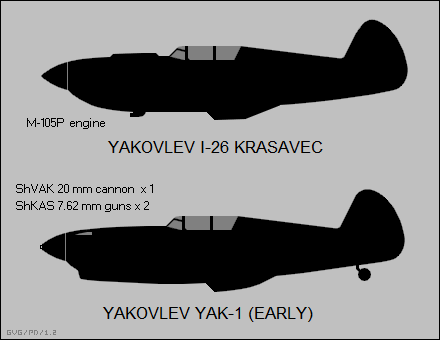
By the time of the German invasion of the USSR on 22 June 1941, almost 400 Yak-1s had been delivered. Despite the deficiencies of the Yak-1, it was still better than the old Polikarpov fighters that equipped most other fighter units, but remained inferior to the German Bf 109F. Red planes were swept out of the sky by the Luftwaffe, with German pilots achieving a kill ratio of at least ten to one. However, relatively few experienced Soviet pilots were lost; the bulk of the aircraft destroyed were obsolete anyway; and although the Soviets took much greater losses than the Germans, the USSR was much more able to replace them over the long run.
* Even though the Yakovlev production and design facilities were moved wholesale out of the path of the German advance to east of the Urals, production of the Yak-1 was only interrupted for a short time, a tribute to the competent planning of the move. As new Yak-1s were rolled off the production lines for immediate delivery to frontal forces, Yakovlev engineers added new features designed in response to "front-line demand" by Red pilots.
Beginning in the summer of 1941, Yak-1s were also fitted with the improved Klimov M-105PA engine, which was more reliable than the M-105P, if still not entirely satisfactory, and could operate in inverted flight and negative-gee maneuvers. A number of winterized Yak-1s, with retractable ski landing gear, white paint, and other cold-weather refinements, were produced in the winter of 1941:1942. The racks for the RS-82 rockets were eliminated from production in the spring of 1942, since they degraded the aircraft's performance. They were replaced by underwing racks for a total of two bombs of up to 100 kilograms (220 pounds) each. However, the Yak-1 simply didn't have enough horsepower to carry that kind of a load well, and in practice it was used as a fighter-bomber only in a pinch.
A number of stripped down Yak-1s were also built, fitted only with the ShVAK cannon and with other items deleted. They weren't faster in level flight than a conventional Yak-1, but they had a superior rate of climb and were a better match for Luftwaffe Bf 109Fs and Bf 109Gs. The "lightweight" Yak-1s were delivered in small quantities and provided to the best pilots, who could make use of the machine's superior climb and maneuverability and were good enough shots to score kills with the single gun.
* Several major changes were made in Yak-1 production in the early summer of 1942. One was fit of the uprated Klimov M-105PF engine, providing 900 kW (1,210 HP) for take-off. This increased performance considerably, giving a maximum speed of about 585 KPH (364 MPH) at altitude. A second change was replacement of the two 7.62-millimeter machine guns by a single 12.7-millimeter Berezin machine gun, mounted on the left side of the nose.
The most visible change was a three-piece all-round vision canopy. The Yak-1's poor rearward vision had been a common complaint among pilots, and many field units had installed a rear-fuselage window panel to improve matters. The all-round vision canopy was a much better solution, though it meant that the 8-millimeter armor plate that protected the pilot's head and shoulders had to be replaced by an armor glass plate 75 millimeters (3 inches) thick behind the pilot's head and shoulders.
Other improvements included a retractable tailwheel; navigation lights; updated engine intakes, exhausts, and other fittings; and multi-channel radios, fitted more or less as standard. The aircraft could be fitted with a camera for battlefield reconnaissance. The improved machine was still formally a Yak-1, but it was referred to as a "Yak-1B" by field units. Some sources also call it the "Yak-1M", but this designation appears to have actually been applied to prototypes for the Yak-3 fighter, discussed below.
* Evolution of the Yak-1 continued, the next significant advance being introduction of the Klimov M-106 inline engine. The M-106 was an evolved version of the M-105PF, being fitted with an improved supercharger system. A Yak-1 fitted with the M-106 performed its first flight in January 1943. This machine also featured metal wing spars and other metal assemblies. Flight trials went well and a small batch of M-106-powered Yak-1s was built immediately, though problems with the M-106 led some of them to be re-engined with M-105PF engines. The M-106 would never become a reliable engine.
* The Yak-1 was not quite the equal of the best Luftwaffe fighters, but it was an improvement over other Soviet types available at the time, and the best VVS pilots made good use of it. One of the more interesting Yak-1 pilots was Lidya Litvak, a woman who was flight commander of an otherwise male air regiment. She scored 12 kills, before falling herself on 1 September 1943, at the age of 21.
The Yak-1 not only equipped Soviet units, it also was provided to Polish, Yugoslavian, and French volunteer units operating under Red Army control. The French volunteer unit was the famous Normandie-Niemen air regiment, which scored many victories against the Luftwaffe in the Soviet "Great Patriotic War" against Hitler. Production of the Yak-1 series was phased out in the summer of 1944. By that time, some 8,666 of them had been built.
BACK_TO_TOP* The Yak-1 was taken out of production to make way for a improved variant, known as the "Yak-3". Confusingly, however, there were two essentially different aircraft with the designation Yak-3.
The original Yak-3, which was originally designated "I-30" and offered along with the I-26 as an alternate design, made its first flight on 12 April 1941. This machine generally resembled the I-26, but was of all-metal construction and had a wing with dihedral on the outer panels. Like the early Yak-1, it had a ShVAK 20-millimeter cannon firing through the prop spinner and twin ShKAS 7.62-millimeter machine guns in the nose, but was also fitted with a ShVAK cannon in each wing. It was powered by a Klimov M-105P engine.
The first of two prototypes was fitted with a slatted wing to improve handling and short-field performance. The second prototype had a wooden wing without slats, in order to simplify production. The second prototype crashed during flight tests and was written off. Although there were plans to put the Yak-3 into production, the scarcity of aviation aluminum and the pressure of the Nazi invasion led to abandoning work on the first Yak-3 in the late fall of 1941.
During roughly the same timeframe, the Yakovlev bureau also worked on a high-altitude fighter, initially designated the "I-28" and then "Yak-5". It performed its first flight on 1 December 1940. The I-28 / Yak-5 was similar to the I-26 / Yak-1, the main difference being that the I-28 was fitted with a Klimov M-105PD engine with an advanced supercharger optimized for high-altitude performance. The engine proved troublesome, with the I-28 effort being abandoned about the same time as the original Yak-3 effort. The OKB would continue to tinker with the high-altitude fighter concept, but using other variants in the Yak fighter line.
* There never was an operational Yak-5, but the Yak-3 designation was recycled and applied to a highly successful Yak fighter variant. The second Yak-3 was not really a new aircraft, instead being a continued evolution of the Yak-1. The powerplant was intended to be the new Klimov M-107 engine, providing over 1,120 kW (1,500 HP). However, the M-107 suffered development problems, and so the Klimov M-105PF was retained. The most significant changes in the Yak-3 were a shorter wingspan; a new canopy with better all-round visibility; and a modified oil cooler scheme. Early production Yak-3s would have the same single 20-millimeter ShVAK cannon and Berezin 12.7-millimeter machine gun as the Yak-1B, but later production would have an improved ShA-20M 20-millimeter cannon, plus two Berezin 12.7-millimeter guns in the nose.
___________________________________________________________________
YAKOVLEV YAK-3:
___________________________________________________________________
wingspan:
9.2 meters (30.2 feet)
wing area:
14.85 sq_meters (159.8 sq_feet)
length:
8.49 meters (27.8 feet)
height:
3.28 meters (7.94 feet)
empty weight:
2,105 kilograms (4,641 pounds)
max loaded weight:
2,550 kilograms (5,622 pounds)
maximum speed:
655 KPH (405 MPH / 355 KT)
service ceiling:
10,700 meters (35,100 feet)
range:
900 kilometers (560 MI / 485 NMI)
___________________________________________________________________
Two prototypes were built, designated "Yak-1M", with the "M" standing for "Modifikatsirovany (Modified)". Flight tests began in early 1943 and the performance of the new variant proved even more impressive than had been anticipated. The new variant was capable of 680 KPH at 3.7 kilometers altitude (422 MPH at 12,140 feet) and had marvelous agility at low altitude.
The Yak-1M was ordered into production with minor changes as the Yak-3 in October 1943, with first rollouts in March 1944. The type was being delivered in quantity to VVS frontline units by the summer of 1944. VVS pilots were extremely enthusiastic about the type, since it was a real threat to the Luftwaffe Focke-Wulf Fw 190A and Messerschmitt Bf 109G. The Yak-3 was one of the smallest and lightest major combat fighters fielded by any combatant during the war, and its high power-to-weight ratio gave it excellent performance. It could easily out-turn its adversaries, though like many "hot" aircraft, it could be a dangerous handful on take-off and landing.
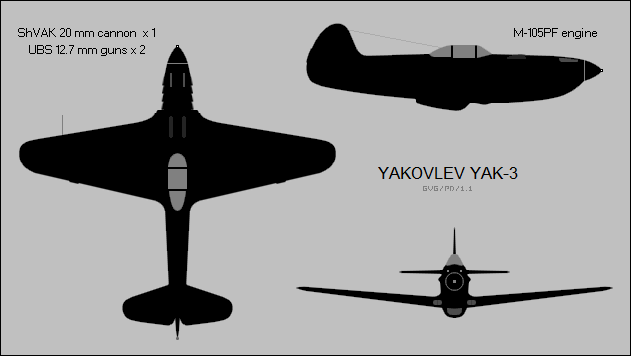
* In late production, the Yak-3 was fitted with an armament of three lightweight B-20 20-millimeter cannon. Almost 600 of these machines were built, mostly after the war, and designated "Yak-3P", where "P" stood for "Pushka (Cannon)". There were a number of specialized variants of the Yak-3 that never went beyond the prototype stage:
Yak-3 production was shut down in 1946. 4,848 were built in all, with 737 of them delivered after the war. They would continue to be flown for a few years in the postwar period by the VVS, as well as the French, Yugoslavians, Albanians, and Poles. One of the French examples is now in the Musee de l'Air near Paris.
* In the early 1990s, the Yakovlev organization actually put the Yak-3 back into production as the "Yak-3U", building a small batch that was sold to private "warbird" collectors by a company in California. These machines were actually fitted with American Allison V-1710 inline engines, since workable Klimov engines could no longer be found at any reasonable cost. Retooling production for an aircraft that was designed to be easy to build was probably straightforward as such things go, and the work was assisted by engineers and production workers who had worked on the machine in the 1940s, lured out of retirement by a chance to make some money and relive old times.
BACK_TO_TOP* The Yak-1 and Yak-3 variants represented one branch of the evolution of the Yakovlev piston fighters, known as the "lightweight" fighters. Another branch of "heavy" fighters evolved in parallel, beginning with the "Yak-7". The Yak-7 actually began life in 1939 as a tandem-seat advanced trainer, originally designated "I-27" and then "UTI-26", offered along with the original I-26 proposal. The "UTI" suffix stood for "Uchebno Trenirovochnyi Istrebitel / Training Fighter". Yakovlev was clearly a very energetic person, promoting four different aircraft designs at the same time, including the I-26, UTI-26, I-28, and I-30.
The two-seater UTI-26 was intended to give students familiarization with a fast and hot aircraft before they went on to fly the single-seat I-26. This would reduce the number of losses in training. The two-seater could also be used for liaison and fast transport duties.
Formal work on the UTI-26 began in the spring of 1940, and the prototype first flew on 23 July 1940. The trainer was essentially a modified I-26, fitted with a second cockpit and dual controls. A rubber speaking tube was used as an "intercom" between the cadet and the flight instructor. The wing was moved back slightly to preserve balance. The UTI-26 inherited all the flaws of the I-26, but it was put into production anyway in March 1941 as the "Yak-7UTI". It was armed with a single ShKAS 7.62-millimeter machine gun in the cowling.
Early Yak-7UTIs retained retractable main landing gear -- but beginning in the summer of 1941, the type was produced with fixed landing gear as a means of simplifying production, the reduction in performance being regarded as acceptable for a trainer. Skis could be fitted for winter operations. The machine gun was also removed. The result was designated "Yak-7V", where "V" stood for "Vyvozoni (Familiarization)". The trainer variants of the Yak-7 were built in quantities of hundreds.
* At about the same time that the trainers switched to fixed landing gear, a team at one of the production plants converted one of the trainers fitted with retractable landing gear to a full-fledged fighter configuration, with two ShKAS 7.62-millimeter machine guns in the cowling, a ShVAK 20-millimeter cannon firing through the prop spinner, and racks for six RS-82 rockets. An armored backrest was added to the pilot's seat, and protected fuel tanks were fitted. The rear cockpit position was retained, allowing it to accommodate a second seat (without controls) for fast courier and transport duties; a fuel tank for extended range; or in principle bombs or other gear.
Yakovlev himself wasn't enthusiastic about the idea of converting the Yak-7 into a fighter, but he ran it upstairs to his political bosses. They liked the concept, and so he warmed to the idea himself. Since the Yak-7UTI was already in production, building the "Yak-7" fighter was straightforward, and the type was in weapons trials by mid-September.
By the end of 1941, about 60 Yak-7 fighters had been built, and the type had been in combat. Its flight performance was similar to the Yak-1, though it was less maneuverable. Of course, improvements were made to the type, with the fighter given the new designation of "Yak-7A" at the beginning of 1942. The changes included fit of a radio; restoration of the semi-retractable tailwheel; replacement of the rear canopy with a plywood hood that hinged open to the side; fit of a pilot oxygen system; and a modified instrument panel. Most of the modifications were actually introduced in the months following the designation change.
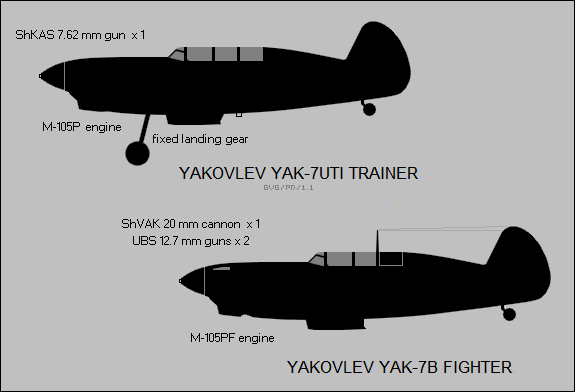
Improvements continued, leading to the introduction of the "Yak-7B" in the spring of 1942. The Yak-7B was originally powered by the M-105PA engine and then the M-105PF engine, and also featured more powerful armament, retaining the ShVAK 20-millimeter cannon, but switching the two ShKAS 7.62-millimeter machine guns in the cowling for two Berezin 12.7-millimeter machine guns. Given the high rate of fire of these weapons, this armament gave the Yak-7B good firepower.
The Yak-7B was also fitted with an RSI-4 radio and had a number of aerodynamic improvements, as recommended by the TsAGI (Tsentral'nyi Aerogidrodynamichesky Institut / Central Aerodynamic & Hydrodynamic Research Institute), for example revised engine intakes that improved high altitude performance. Although the Yak-7B weighed about 100 kilograms (220 pounds) more than the Yak-7A, due to the improved engine and aerodynamics the Yak-7B had slightly better performance.
The Yak-7B was originally fitted with launch rails for six RS-82 rockets and racks for two 100-kilogram (220-pound) bombs. The rocket launch rails were quickly removed from production since they degraded performance too much, but the bomb racks were retained.
Early field feedback on the Yak-7B indicated that it was nose-heavy, tending to tip forward on landings when the brakes were applied, and as compensation the factory installed a fuel tank in the rear cockpit space. That didn't make the pilots any happier, since they were now sharing the cockpit with an unprotected fuel tank, and it raised the loaded weight of the machine too much anyway. The tank was generally removed in the field.
* Several Yak-7 variants were built in small quantities or as prototypes:
* A total of 6,399 Yak-7s of all types was built before production ended in early 1943, with more than 5,000 of this total being Yak-7Bs. After the war, some Yak-7V trainers were provided to the Poles and a single Yak-7V was delivered to the Hungarians for familiarization with the Yak-9 fighter, discussed below.
BACK_TO_TOP* The lessons learned in the Yak-1, Yak-3, and Yak-7 were finally put to use in the most potent, and most heavily produced, of the Yak prop fighter family, the "Yak-9". The Yak-9 was conceived as a natural progression from late model Yak-7 fighters. In the late spring of 1942, the increased availability of aviation aluminum alloys led to the development of a reconnaissance variant of the Yak-7 with a new wing, featuring metal H-section spars with Bakelite-impregnated wood skinning. The new wing had shorter span but the same wing area. The metal spars permitted an increase in fuel capacity, with eight tanks in the wings along with the single fuselage tank, and this variant was designated the "Yak-7D", with "D" standing for "Dal'ny (Long Range)".
Since the Yak-7D seemed promising, Yakovlev then ordered the development of a comparable fighter variant, the "Yak-7DI" (where "DI" stood for "Dal'ny Istrebitel"). This aircraft was based on the Yak-7B with the new Yak-7D wing, though with only four fuel tanks; the right Berezin 12.7-millimeter machine gun removed to reduce weight; an M-105PF engine; and a new all-round vision canopy.
Trials of the Yak-7DI were completed in the late summer of 1942, and the type was put into production as the "Yak-9", with the number of wing tanks reduced to two to cut weight. The new Yak-9 variant reached full production in late 1942 and early 1943. By December 1942, early production Yak-9s were in combat, participating in the great winter counteroffensive at Stalingrad.
* The first refinement of the Yak-9 was the "Yak-9T", where "T" stood for "Tyazhelowooruzheny (Heavily Armed)", fitted with an NS-37 37-millimeter cannon firing through the propeller spinner, instead of the ShVAK 20-millimeter cannon. The variant went through evaluation in early 1943, going into field service by the spring of that year. It proved very popular, with 2,748 built.
To accommodate the cannon, the cockpit was moved 40 centimeters (16 inches) towards the rear. While some sources claim that the Yak-9T was designed as a close-support aircraft, it seems more plausible that the fit of the NS-37 cannon was mainly to correct the inadequate firepower that had dogged the Yak-series fighters; the Yak-9T was primarily used for air combat. The USSR had an optimized machine for close support, the heavily armored Ilyushin Il-2 Shturmovik.
A long-range "Yak-9D" variant was introduced at roughly the same time, and featured four wing tanks, giving the machine a range of 900 kilometers (560 miles). Since the Red Army was on the advance, and it was not always possible to have forward airfields close to the lines, the VVS had acquired a need for a longer-range fighters. Over 3,000 Yak-9Ds were built. The additional wing tanks led to a reduction in performance, and so in early 1944 a number of aerodynamic improvements suggested by TsAGI were incorporated into Yak-9D production to compensate.
The "Yak-9M" was a modest change to the Yak-9D, with the cockpit moved backwards to improve production compatibility with the Yak-9T. This was actually an improvement from the pilot's point of view as well, since moving the cockpit back did not obstruct the pilot's view, while it helped reduce the degree of noseheaviness that the Yak-9 had inherited from the Yak-7. The Yak-9M was also fitted with a jettisonable cockpit canopy, an engine dust filter, and other minor refinements. The variant went into production in the spring of 1944, and over 4,200 would be built.
* Considerable effort was made to reduce production defects in the Yak-9M. The managers responsible had been personally and angrily reprimanded to their faces by Stalin himself when they informed him of problems with the delamination of the wing skinning of the Yak-9: "Oh, but do you know that only the most perfidious enemy could do such a thing?! Producing aircraft at the plant that proved unfit for service at the Front! The enemy could not damage us so cruelly! He could invent nothing worse! This is work for Hitler!"
Stalin did not make empty threats, and he rarely made a threat twice. Defects were fixed with a literally round-the-clock effort, and then Yakovlev and production engineers went on to add improvements. The result was the "Yak-9U", where "U" stood for "Uluchshenniy / Improved". The Yak-9U was difficult to tell from the Yak-9M from the outside, but it incorporated a wide range of small changes to improve performance and survivability.
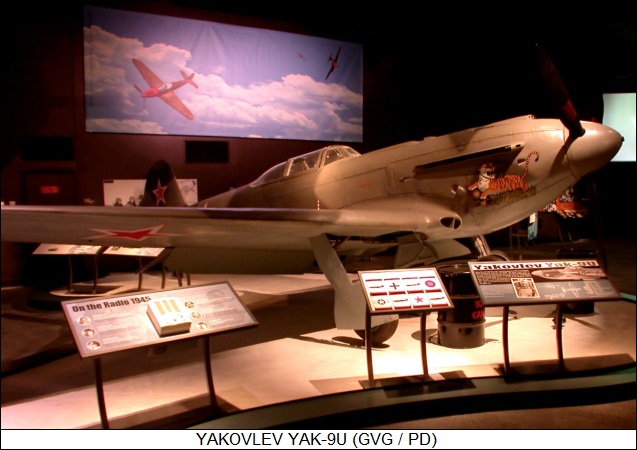
The Yak-9U was initially fitted with the Klimov M-107 engine, but problems with the engine led to the loss of the prototype in late February 1943. As a result, the Yak-9U retained the M-105PF engine. It also featured two Berezin 12.7-millimeter guns, as well as the ShVAK 20-millimeter cannon. The Yak-9U was regarded as equivalent in performance and handling to its American counterpart, the P-51D Mustang.
Over 3,900 Yak-9Us were built, the majority of them before the end of the war. Over 280 similar "Yak-9UTs" were built as well, the only real difference being that the design permitted the installation of a heavier cannon on the production line -- a concept derived from the experimental "Yak-9TK", discussed below.
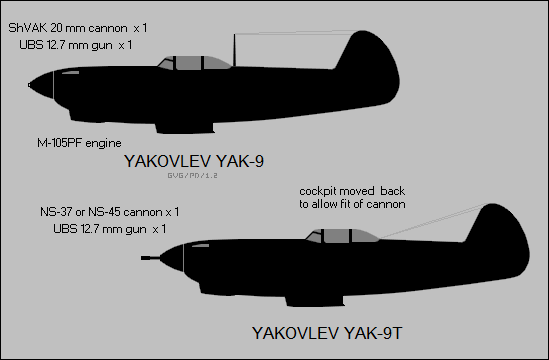
The last version of the Yak piston fighters was the "Yak-9P", which was introduced into service in 1946. The Yak-9P featured all metal-construction -- except for the earliest production, which retained wooden elements in the fuselage. It had four wing fuel tanks and various niceties such as a radio compass; an "identification friend or foe (IFF)" unit; a gun camera; and "glow in the dark" cockpit indicators.
___________________________________________________________________
YAKOVLEV YAK-9P:
___________________________________________________________________
wingspan:
9.77 meters (32.05 feet)
wing area:
17.15 sq_meters (184.6 sq_feet)
length:
8.55 meters (28 feet)
height:
2.96 meters (9.71 feet)
empty weight:
2,716 kilograms (5,988 pounds)
max loaded weight:
3,395 kilograms (7,485 pounds)
maximum speed:
675 KPH (420 MPH / 365 KT)
service ceiling:
11,900 meters (39,000 feet)
maximum range:
1,200 kilometers (745 miles / 650 NMI)
___________________________________________________________________
About 800 Yak-9Ps were built. The Yak-9P was supplied to many Soviet satellite air forces in the early postwar period, including North Korea. During the early parts of the Korean War, North Korean Yak-9Ps came head-to-head with American F-51D Mustangs and F-82G Twin Mustangs. The Yak-9P seems to have come off the worse in these encounters -- though it seems more because of limited North Korean pilot training and not any inherent inferiority of the aircraft. The US captured and evaluated a Yak-9P and pilot reports indicated that it was an extremely capable aircraft, though its manufacturing and finish quality were rough by Western standards.
Apparently a different Yak-9P variant had been built earlier in World War II, featuring armament of twin 20-millimeter cannon, but it never got beyond the prototype stage, and the designation was recycled later for the more Yak-9P.
* A number of other Yak-9 variants were built as prototypes or produced in limited numbers:
* After World War II, the Yugoslav designers Sivar, Znic, and Popovic designed a fighter based on the Yak-9 named the "S-49" that would serve into the 1950s. It was the last of a significant line of aircraft.
A total of 16,769 Yak-9 fighters had been built by the time production ceased in 1947 -- making it not only more common than all other Yak fighter variants put together, but one of the most heavily produced aircraft of all time. The total number of all Yak fighter variants was 36,737. Many Yak pilots would become aces, and a few would score 50 kills or more in the Yak and other fighters. Among them were Dmitri Glinka, with 50 kills; Grigori Rechakov, with 56 kills; and the famous Alexandr Pokryshin, with 59 kills.
BACK_TO_TOP* Although the Yak piston fighters were effectively obsolete by the end of World War II, the line did not come to a dead end in the postwar period. Late in the conflict, the Yakovlev OKB began work on a tandem-seat trainer derivative of the Yak-3, to be powered by a Shvetsov ASh-21 9-cylinder air-cooled radial engine with 425 kW (570 HP). The trainer was originally to be designated the "Yak-3UTI", where "UTI" stood for "Uchebno Trenirovochnyi Istrebitel (Fighter Trainer)", and the original prototype performed its first flight on 10 November 1945.
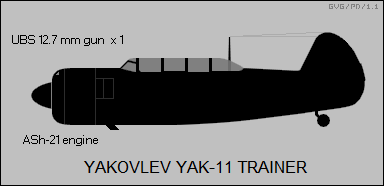
The type passed its trials successfully, being ordered into production as the "Yak-11" in 1946, with service deliveries starting in 1947. It had a metal wing with a slightly increased span and retractable main gear, but a fixed tailwheel. It was armed with a single 12.7-millimeter Berezin or 7.62-millimeter ShKAS machine gun, and could carry a light bomb under each wing, the armament being intended for weapons training. The ASh-21 engine drove a two-bladed propeller.
___________________________________________________________________
YAKOVLEV YAK-11:
___________________________________________________________________
wingspan:
9.4 meters (30 feet 10 inches)
wing area:
15.4 sq_meters (165.77 sq_feet)
length:
8.50 meters (27 feet 10 inches)
height:
3.28 meters (7.94 feet)
empty weight:
1,900 kilograms (4,189 pounds)
MTO weight:
2,440 kilograms (5,379 pounds)
maximum speed:
465 KPH (290 MPH / 250 KT)
service ceiling:
7,100 meters (23,300 feet)
range:
1,280 kilometers (795 MI / 690 NMI)
___________________________________________________________________
The Yak-11 was apparently great fun to fly, and was manufactured in large quantities; 3,859 were built in the USSR, with another 707 built in Czechoslovakia from 1953 as the "C-11". NATO assigned the type the reporting name "Moose", something of a slight for such an agile aircraft. The Yak-11 was the standard East Bloc primary trainer through the 1950s and into the 1960s, and was provided to almost every Soviet ally and client state. It was also used as a liaison aircraft, squadron "hack", and for aerobatic displays.
A variant with tricycle landing gear was flown in 1958, with the designation of "Yak-11U", and built in small quantities, with a few built by the Czechs as the "C-11U". Many Yak-11s remain flightworthy, being flown as air racers, or on the warbird circuit.
BACK_TO_TOP* The list below provides a summary of Yak piston fighter variants:
* While there are murky points in the documentation for almost every aircraft, trying to track down some odd details for Soviet aircraft is an exercise in frustration and contradiction. Even if the Soviets hadn't been secretive, fighters like the Yak-1 were being refined from brutal combat experience while the Russians were moving whole industries hundreds of kilometers as part of a bitter struggle for survival.
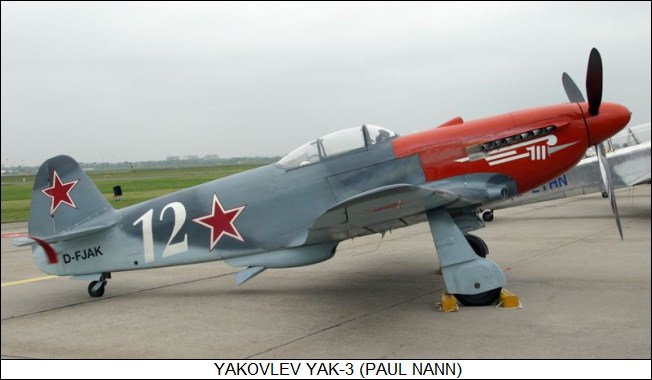
In any case, the documentation trail is muddy and confusing, and for perfectly understandable reasons. There are major disagreements between sources on the Yak fighter, and though it is relatively straightforward to identify a Yak-1, Yak-3, Yak-7, or Yak-9, assignment of a particular subvariant type and specification should be taken with a bit of skepticism. Given the time that has passed after the events of the story, it is very possible that the confusion will never be completely straightened out.
* Sources for this document include:
* Revision history:
v1.0 / 01 apr 99 v1.1.0 / 01 jun 02 / Moderate rewrite. v1.1.1 / 01 aug 04 / Review & polish. v1.1.2 / 01 jul 06 / Review & polish. v1.1.3 / 01 jan 07 / A few bug fixes. v1.1.4 / 01 aug 08 / Review & polish. v1.1.5 / 01 jul 10 / Review & polish. v1.2.0 / 01 jun 12 / Relocated early Yak history section elsewhere. v1.2.1 / 01 may 14 / Review & polish. v1.2.2 / 01 apr 16 / Review & polish. v1.2.3 / 01 mar 18 / Review & polish. v1.2.4 / 01 jan 20 / Review & polish. v1.2.5 / 01 nov 21 / Review & polish. v1.2.6 / 01 oct 21 / Review & polish.BACK_TO_TOP
